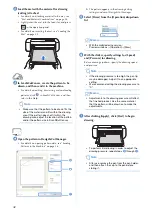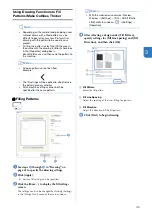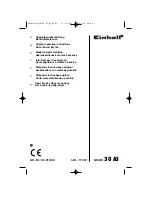
29
1
Peeling Off the Material (Excluding Quilt
Piecing)
After cutting the material, use a spatula to peel off
the fabric together with the attached contact
sheet.
a
Pattern that was cut out
b
Contact sheet
c
Spatula
Note
•
Do not place anything heated on the fabric
attached to a contact sheet. The adhesive will
permeate any other pieces of fabric around.
Attaching Fabrics With the Double-
Sided Adhesive
Place a cutout on a base fabric and apply pressure
on the top of the cutout using an iron. (The
contact sheet may not adhere well to some
fabrics.) Hand or machine stitch to ensure that the
cutout stays in place.
a
Base fabric
b
Cutout with a contact sheet
Note
• Do not wash fabrics attached with a double-
sided adhesive contact sheet.
• When attaching fabrics with the double-sided
adhesive, iron carefully, being sure that the
material and adhesive surfaces are properly
heat-set.
• When attaching fabrics of different weights with
the double-sided adhesive, first iron the lighter-
weight fabric to affix the contact sheet.
Notice on Use of Iron-on Fabric
Appliqué Contact Sheet
• Store the contact sheet at room temperature
and in a location not exposed to high
temperatures, high humidity or direct sunlight.
■
Fabric (for Quilt Piecing)
a
Standard mat
b
High tack adhesive fabric support sheet
Attaching the Material (for Quilt Piecing)
Use the high tack adhesive fabric support sheet to
attach fabrics for quilt piecing to the standard
mat. These sheets should only be used with
patterns that have a seam allowance. The high
tack adhesive fabric support sheet can be
repeatedly used until their adhesive strength has
decreased. (Once the support sheet has been
peeled off the mat, it can no longer be used.)
a
Peel off the protective sheet from the adhesive
side of the standard mat.
a
b
c
a
b
b
a
















































